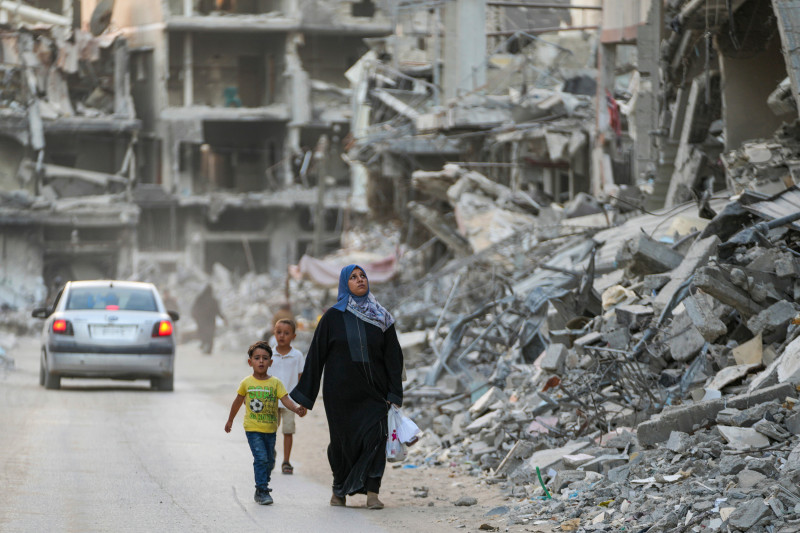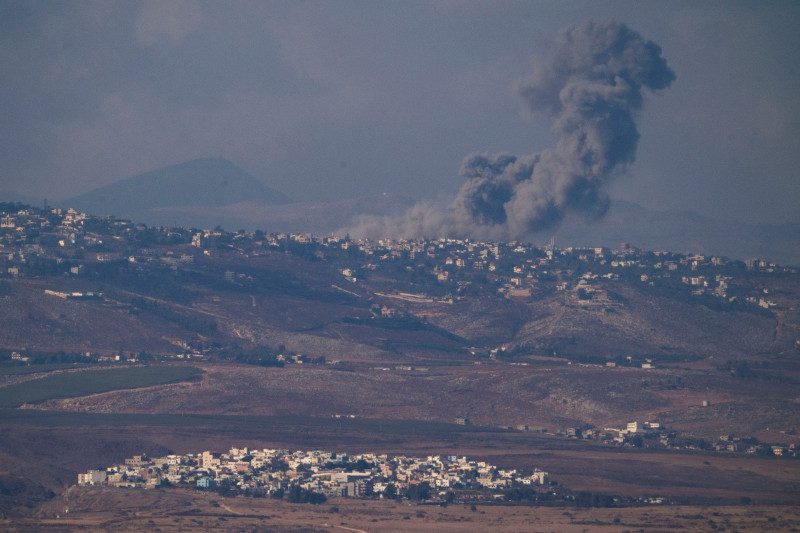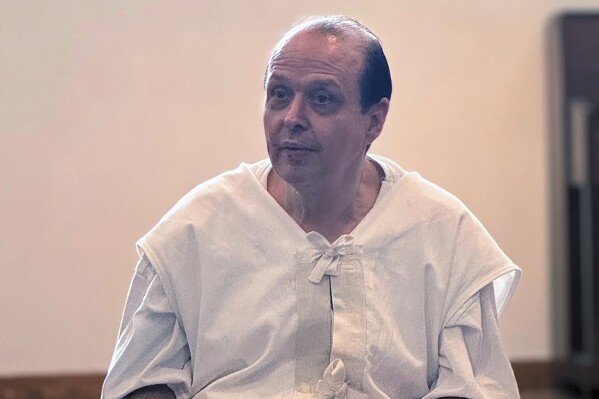Your support helps us to tell the story
Support NowThis election is still a dead heat, according to most polls. In a fight with such wafer-thin margins, we need reporters on the ground talking to the people Trump and Harris are courting. Your support allows us to keep sending journalists to the story.
The Independent is trusted by 27 million Americans from across the entire political spectrum every month. Unlike many other quality news outlets, we choose not to lock you out of our reporting and analysis with paywalls. But quality journalism must still be paid for.
Help us keep bring these critical stories to light. Your support makes all the difference.
The leader of Hamas, Yahya Sinwar – seen as the mastermind of the 7 October attack – has been killed in Gaza, Israel has said.
Israeli prime minister Benjamin Netanyahu, speaking in Jerusalem just after the death was confirmed, said Sinwar’s death offered the chance of peace in the Middle East but warned that the war in Gaza was not over and Israel would continue until its hostages were returned.
“Today we have settled the score. Today evil has been dealt a blow but our task has still not been completed,” Netanyahu said in a recorded video statement. “To the dear hostage families, I say: this is an important moment in the war. We will continue full force until all your loved ones, our loved ones, are home.”
Foreign minister Israel Katz said of his nation’s most wanted man: “Mass murderer Yahya Sinwar, who was responsible for the massacre and atrocities of 7 October, was killed today by [Israeli] soldiers”. The killing represents a major boost to the Israeli military after a string of high-profile assassinations of prominent leaders of its enemies in recent months.
Sinwar is thought to have engineered the attack along with Mohammed Deif, who was killed in an airstrike on Gaza in July. The same month, Hamas’s political leader, Ismael Haniyeh, was assassinated in a strike in Iran.
The 7 October attack killed around 1,200 Israelis, while another 251 people were taken hostage. Israel’s retaliatory war inside Gaza from land and air has killed 43,000 Palestinians, according to health authorities in Gaza.
Israel’s Kan Radio reported that Sinwar had been killed “by chance”. The station also said his body and those of two other Hamas members were found with money and fake IDs.
Channel 12 reported that the incident in question took place on Wednesday in the southern city of Rafah. Troops who spotted several fighters entering a building ordered a tank strike against it, which collapsed the structure. Graphic photos and video from the scene, broadcast on Israeli media, showed what appeared to be Sinwar’s body, with a head wound, dressed in a military-style vest, half buried in the rubble of a destroyed building.
The Israeli military said it has been operating in southern Gaza following intelligence “that indicated the suspected locations of senior members of Hamas”. Soldiers from the 828th Brigade operating in the area “identified and eliminated three terrorists”, it said, adding an identification process confirmed one of those killed was Sinwar.
The military said there were no signs that hostages had been present in the building where the three were killed. There had been reports from the Israeli army that Sinwar had been hiding among hostages in tunnels under Gaza. Channel 12 reported, without citing a source, that Sinwar had been hiding with the six hostages whose bodies were recovered by the Israeli military in August. The six had been killed by their captors as Israeli troops approached.
“This is a significant military and moral achievement for Israel and a victory for the entire free world,” Mr Katz said in a statement. “The assassination of Sinwar will create the possibility to immediately release the hostages and to bring a change that will lead to a new reality in Gaza – without Hamas and without Iranian control,” Mr Katz added, a reference to Hamas being backed by Tehran.
President Joe Biden said the assassination was a “good day for Israel, for the United States, and for the world,” calling it an “opportunity” to free hostages held by the militant group and end the yearlong war in Gaza. He spoke with Mr Netanyahu hours after the killing was reported.
Sir Keir Starmer also issued a statement on the death of Sinwar. “The UK will not mourn his death,” the prime minister said.
“The release of all hostages, an immediate ceasefire and an increase in humanitarian aid are long overdue so we can move towards a long-term, sustainable peace in the Middle East.”
The last known footage of Sinwar shows a stooped man walking through a tunnel beneath Gaza, accompanied by his wife and children. The video was retrieved by Israeli soldiers during a raid on Gaza earlier this year but is thought to date to the days immediately after the 7 October attack.
Sinwar was chosen as the group’s top leader following the assassination of Haniyeh. He has proven to be Israel’s hardest target, with the military sparing no expense in trying to hunt him down. A taskforce of intelligence officers, special operation units, military engineers and surveillance experts were all involved but, in the end, he was killed by soldiers on patrol.
Israeli defence minister Yoav Gallant posted a message on social media platform X ahead of the announcement by Mr Katz: “Our enemies cannot hide. We will pursue and eliminate them.”
The post contained pictures of former Hezbollah leader Hassan Nasrallah, who was assassinated in Beirut last month and Deif, with a blank space for a third picture between them. All three were crossed out in red. He later updated the photo to include a picture of Sinwar.

Israel’s Army Radio said DNA and dental tests had been conducted. Israel has samples of Sinwar’s DNA from a period in an Israeli jail.
Sinwar was born in 1962 in a refugee camp in the Gaza town of Khan Younis. An early member of Hamas from its inception in 1987, he eventually led the group’s security arm which worked to purge it of spies for Israel.
Israel arrested him in the late 1980s and he admitted to killing 12 people, a role that earned him the nickname “The Butcher of Khan Younis”. He was sentenced to four life terms for offences that included the killing of two Israeli soldiers.
Sinwar was released from prison in 2011 by Mr Netanyahu as part of an exchange for an Israeli soldier, Gilad Shalit, captured by Hamas in a cross-border raid. He quickly rose to head of Hamas in Gaza, effectively putting him in control of the territory, and worked with Haniyeh to align the group with Iran and its proxies around the Middle East.
In recent months, Israel has killed several commanders of Hamas in Gaza as well as senior figures of Hezbollah in Lebanon – including its veteran leader Nasrallah – as it has intensified strikes, particularly against Hezbollah in Lebanon, across Israel’s northern border. Israel has also launched a ground invasion into southern Lebanon in tandem with the increased strikes. Hezbollah and Israel had started trading near-daily cross-border fire in the wake of Israel launching its war in Gaza.
The Israeli military said on Thursday that over the past 24 hours, it had killed 45 Hezbollah fighters in southern Lebanon, including a battalion commander, and seized many weapons. Israeli operations in Lebanon have killed at least 2,350 people over the last year, according to the health ministry, and more than 1.2 million people have been displaced. Around 50 Israelis, both soldiers and civilians, have been killed in the same period, according to Israel.
The Israeli military has also issued evacuation warnings for residents of the Bekaa Valley in eastern Lebanon, focusing on three buildings in Tamnine town and Saraain El Tahta and Sefri villages where it said Hezbollah maintained facilities.

"For your safety and the safety of your family, you must evacuate this building and the surrounding buildings immediately and stay at least 500 metres away from them," military spokesperson Avichay Adraee posted on X.
Iran’s allies in its so-called “axis of resistance” – Hezbollah, Hamas, Yemen’s Houthis, and armed groups in Iraq – have carried out attacks in the region in support of the Palestinians in Gaza.
The confirmation of Sinwar’s death will dial up tensions in the Middle East where fears of a wider conflict have grown as Israel plans its response to an attack, featuring 180 ballistic missiles, carried out by Iran in response to Israel’s intensified strikes on its proxies.
The commander of Iran’s Revolutionary Guards warned Israel earlier on Thursday against attacking Iran. “We tell you [Israel] that if you commit any aggression against any point we will painfully attack the same point of yours,” Hossein Salami said in a televised speech, adding that Iran can penetrate Israel’s defences, which knocked the majority of Iran’s missiles out of the sky, with help from the US and other allies.
There has been speculation that Israel could strike Iran’s nuclear facilities, as it has long threatened to do, while other options include attacks on its vital oil sites.
It comes as at least 28 Palestinians, including children, were killed in an Israeli strike on a shelter in the northern Gaza Strip, a Gaza health ministry official said. Dozens of people were also injured in the strike, Medhat Abbas told Reuters, as Israel’s bloody assault on northern Gaza continues. The Hamas-run Gaza government media office put the number of wounded at 160.
The Israeli military said dozens of militants were present in the shelter, claiming it had carried out a precise strike on Hamas and Islamic Jihad fighters inside the compound.
Tanks were sent by the Israeli military into Jabalia in the north, where United Nations officials expressed concern over shortages of food and medicine.
A report by the International Labour Organisation (ILO) revealed unemployment in Gaza has hit nearly 80 per cent since the outbreak of the Israel-Hamas war, with almost the entire 2.3 million population forced into poverty.
Referring to both Gaza and the West Bank, the ILO said the conflict had caused “unprecedented and wide-ranging devastation on the labour market and the wider economy across the Occupied Palestinian Territory”.
Gaza’s economic output has also shrunk by 85 per cent since the war began.
Elsewhere, Syrian state media reported that Israel had struck Syria’s port city of Latakia early on Thursday, while US B-2 stealth bombers have been used against the Houthis for the first time in a move that also marks a message to Tehran.
It is believed to be the first time the B-2 has been used in a combat mission since 2017. In announcing the strikes against the Houthis, who have been attacking ships in the Red Sea, the US defence secretary, Lloyd Austin, made a point of issuing a warning that there will be no place that Washington cannot reach.
“This was a unique demonstration of the United States’s ability to target facilities that our adversaries seek to keep out of reach, no matter how deeply buried underground, hardened or fortified,” Mr Austin said.
The “hardened” facilities contained weapon components which the Houthis have used to “target civilian and military vessels throughout the region,” Mr Austin said, but it is not yet clear how much damage has been caused.
Reuters and Associated Press contributed to this report
Disclaimer: The copyright of this article belongs to the original author. Reposting this article is solely for the purpose of information dissemination and does not constitute any investment advice. If there is any infringement, please contact us immediately. We will make corrections or deletions as necessary. Thank you.



